The Effect of Crystal Seeds on Calcium Carbonate Ion Pair Formation in Aqueous Solution: A ReaxFF Molecular Dynamics Study
Abstract
:1. Introduction
2. Simulation Models and Methods
2.1. Models
2.2. Methods
3. Results and Discussion
4. Conclusions
Supplementary Materials
Author Contributions
Funding
Data Availability Statement
Conflicts of Interest
References
- Jimoh, O.A.; Ariffin, K.S.; Hussin, H.B.; Temitope, A.E. Synthesis of Precipitated Calcium Carbonate: A Review. Carbonates Evaporites 2018, 33, 331–346. [Google Scholar] [CrossRef]
- Morse, J.W.; Arvidson, R.S.; Lüttge, A. Calcium Carbonate Formation and Dissolution. Chem. Rev. 2007, 107, 342–381. [Google Scholar] [CrossRef] [PubMed]
- Sulpis, O.; Jeansson, E.; Dinauer, A.; Lauvset, S.K.; Middelburg, J.J. Calcium Carbonate Dissolution Patterns in the Ocean. Nat. Geosci. 2021, 14, 423–428. [Google Scholar] [CrossRef]
- Meldrum, F.C. Calcium Carbonate in Biomineralisation and Biomimetic Chemistry. Int. Mater. Rev. 2003, 48, 187–224. [Google Scholar] [CrossRef]
- Woldetsadik, A.D.; Sharma, S.K.; Khapli, S.; Jagannathan, R.; Magzoub, M. Hierarchically Porous Calcium Carbonate Scaffolds for Bone Tissue Engineering. ACS Biomater. Sci. Eng. 2017, 3, 2457–2469. [Google Scholar] [CrossRef] [PubMed]
- Xu, X.; Han, J.T.; Cho, K. Formation of Amorphous Calcium Carbonate Thin Films and Their Role in Biomineralization. Chem. Mater. 2004, 16, 1740–1746. [Google Scholar] [CrossRef]
- Andritsos, N.; Karabelas, A.J. Calcium Carbonate Scaling in a Plate Heat Exchanger in the Presence of Particles. Int. J. Heat Mass Transfer 2003, 46, 4613–4627. [Google Scholar] [CrossRef]
- Liang, Y.; Xu, Y.; Jia, M.; Wang, J. Experimental Study on the Influence of an Alternating Magnetic Field on the CaCO3 Fouling of a Heat Transfer Surface. Int. J. Heat Mass Transfer 2022, 183, 122156. [Google Scholar] [CrossRef]
- Erdemir, D.; Lee, A.Y.; Myerson, A.S. Nucleation of Crystals from Solution: Classical and Two-Step Models. Acc. Chem. Res. 2009, 42, 621–629. [Google Scholar] [CrossRef]
- Henzler, K.; Fetisov, E.O.; Galib, M.; Baer, M.D.; Legg, B.A.; Borca, C.; Xto, J.M.; Pin, S.; Fulton, J.L.; Schenter, G.K.; et al. Supersaturated Calcium Carbonate Solutions Are Classical. Sci. Adv. 2018, 4, eaao6283. [Google Scholar] [CrossRef]
- Wallace, A.F.; Hedges, L.O.; Fernandez-Martinez, A.; Raiteri, P.; Gale, J.D.; Waychunas, G.A.; Whitelam, S.; Banfield, J.F.; De Yoreo, J.J. Microscopic Evidence for Liquid-Liquid Separation in Supersaturated CaCO3 Solutions. Science 2013, 341, 885–889. [Google Scholar] [CrossRef] [PubMed] [Green Version]
- Schenter, G.K.; Kathmann, S.M.; Garrett, B.C. Dynamical Nucleation Theory: A New Molecular Approach to Vapor-Liquid Nucleation. Phys. Rev. Lett. 1999, 82, 3484–3487. [Google Scholar] [CrossRef]
- Reguera, D.; Reiss, H. Extended Modified Liquid Drop−Dynamical Nucleation Theory (Emld−Dnt) Approach to Nucleation: A New Theory. J. Phys. Chem. B 2004, 108, 19831–19842. [Google Scholar] [CrossRef]
- Dou, X.; Huang, H.; Han, Y. The Role of Diffusion in the Nucleation of Calcium Carbonate. Chin. J. Chem. Eng. 2022, 43, 275–281. [Google Scholar] [CrossRef]
- Gebauer, D.; Völkel, A.; Cölfen, H. Stable Prenucleation Calcium Carbonate Clusters. Science 2008, 322, 1819–1822. [Google Scholar] [CrossRef] [Green Version]
- Avaro, J.T.; Wolf, S.L.P.; Hauser, K.; Gebauer, D. Stable Prenucleation Calcium Carbonate Clusters Define Liquid–Liquid Phase Separation. Angew. Chem. Int. Ed. 2020, 59, 6155–6159. [Google Scholar] [CrossRef]
- Deng, H.; Shen, X.-C.; Wang, X.-M.; Du, C. Calcium Carbonate Crystallization Controlled by Functional Groups: A Mini-Review. Front. Mater. Sci. 2013, 7, 62–68. [Google Scholar] [CrossRef]
- Levi, Y.; Albeck, S.; Brack, A.; Weiner, S.; Addadi, L. Control over Aragonite Crystal Nucleation and Growth: An in Vitro Study of Biomineralization. Chem. Eur. J. 1998, 4, 389–396. [Google Scholar] [CrossRef]
- Mergelsberg, S.T.; Riechers, S.L.; Graham, T.R.; Prange, M.P.; Kerisit, S.N. Effect of Cd on the Nucleation and Transformation of Amorphous Calcium Carbonate. Cryst. Growth Des. 2021, 21, 3384–3393. [Google Scholar] [CrossRef]
- Mahadevan, G.; Ruifan, Q.; Hian Jane, Y.H.; Valiyaveettil, S. Effect of Polymer Nano- and Microparticles on Calcium Carbonate Crystallization. ACS Omega 2021, 6, 20522–20529. [Google Scholar] [CrossRef]
- Ma, M.; Wang, Y.; Cao, X.; Lu, W.; Guo, Y. Temperature and Supersaturation as Key Parameters Controlling the Spontaneous Precipitation of Calcium Carbonate with Distinct Physicochemical Properties from Pure Aqueous Solutions. Cryst. Growth Des. 2019, 19, 6972–6988. [Google Scholar] [CrossRef]
- Tommaso, D.D.; de Leeuw, N.H. The Onset of Calcium Carbonate Nucleation: A Density Functional Theory Molecular Dynamics and Hybrid Microsolvation/Continuum Study. J. Phys. Chem. B 2008, 112, 6965–6975. [Google Scholar] [CrossRef] [PubMed]
- Di Tommaso, D.; Ruiz-Agudo, E.; de Leeuw, N.H.; Putnis, A.; Putnis, C.V. Modelling the Effects of Salt Solutions on the Hydration of Calcium Ions. Phys. Chem. Chem. Phys. 2014, 16, 7772–7785. [Google Scholar] [CrossRef] [Green Version]
- Chaka, A.M. Ab Initio Thermodynamics of Hydrated Calcium Carbonates and Calcium Analogues of Magnesium Carbonates: Implications for Carbonate Crystallization Pathways. ACS Earth Space Chem. 2018, 2, 210–224. [Google Scholar] [CrossRef]
- Tribello, G.A.; Bruneval, F.; Liew, C.; Parrinello, M. A Molecular Dynamics Study of the Early Stages of Calcium Carbonate Growth. J. Phys. Chem. B 2009, 113, 11680–11687. [Google Scholar] [CrossRef] [PubMed]
- Wang, B.-B.; Xiao, Y.; Xu, Z.-M. Variation in Properties of Pre-Nucleation Calcium Carbonate Clusters Induced by Aggregation: A Molecular Dynamics Study. Crystals 2021, 11, 102. [Google Scholar] [CrossRef]
- Dasgupta, N.; Chen, C.; van Duin, A.C.T. Development and Application of Reaxff Methodology for Understanding the Chemical Dynamics of Metal Carbonates in Aqueous Solutions. Phys. Chem. Chem. Phys. 2022, 24, 3322–3337. [Google Scholar] [CrossRef] [PubMed]
- Onawole, A.T.; Hussein, I.A.; Carchini, G.; Sakhaee-Pour, A.; Berdiyorov, G.R. Effect of Surface Morphology on Methane Interaction with Calcite: A Dft Study. RSC Adv. 2020, 10, 16669–16674. [Google Scholar] [CrossRef]
- De Villiers, J.P.R. Crystal Structures of Aragonite, Strontianite, and Witherite. Am. Mineral. 1971, 56, 758–767. [Google Scholar]
- Demichelis, R.; Raiteri, P.; Gale, J.D.; Dovesi, R. The Multiple Structures of Vaterite. Cryst. Growth Des. 2013, 13, 2247–2251. [Google Scholar] [CrossRef]
- Wolf, S.E.; Leiterer, J.; Kappl, M.; Emmerling, F.; Tremel, W. Early Homogenous Amorphous Precursor Stages of Calcium Carbonate and Subsequent Crystal Growth in Levitated Droplets. J. Am. Chem. Soc. 2008, 130, 12342–12347. [Google Scholar] [CrossRef] [PubMed]
- Martínez, L.; Andrade, R.; Birgin, E.G.; Martínez, J.M. Packmol: A Package for Building Initial Configurations for Molecular Dynamics Simulations. J. Comput. Chem. 2009, 30, 2157–2164. [Google Scholar] [CrossRef] [PubMed]
- Plimpton, S. Fast Parallel Algorithms for Short-Range Molecular Dynamics. J. Comput. Phys. 1995, 117, 1–19. [Google Scholar] [CrossRef] [Green Version]
- LAMMPS Molecular Dynamics Simulator. Available online: http://lammps.sandia.gov (accessed on 7 August 2019).
- Hoover, W.G. Canonical Dynamics Equilibrium Phase Space Distributions. Phys. Rev. A 1985, 31, 1695–1697. [Google Scholar] [CrossRef] [PubMed] [Green Version]
- Nosé, S. A Unified Formulation of the Constant Temperature Molecular-Dynamics Methods. J. Chem. Phys. 1984, 81, 511–519. [Google Scholar] [CrossRef] [Green Version]
- Michel, F.M.; MacDonald, J.; Feng, J.; Phillips, B.L.; Ehm, L.; Tarabrella, C.; Parise, J.B.; Reeder, R.J. Structural Characteristics of Synthetic Amorphous Calcium Carbonate. Chem. Mater. 2008, 20, 4720–4728. [Google Scholar] [CrossRef]
- Iskrenova-Tchoukova, E.; Kalinichev, A.G.; Kirkpatrick, R.J. Metal Cation Complexation with Natural Organic Matter in Aqueous Solutions: Molecular Dynamics Simulations and Potentials of Mean Force. Langmuir 2010, 26, 15909–15919. [Google Scholar] [CrossRef] [PubMed]
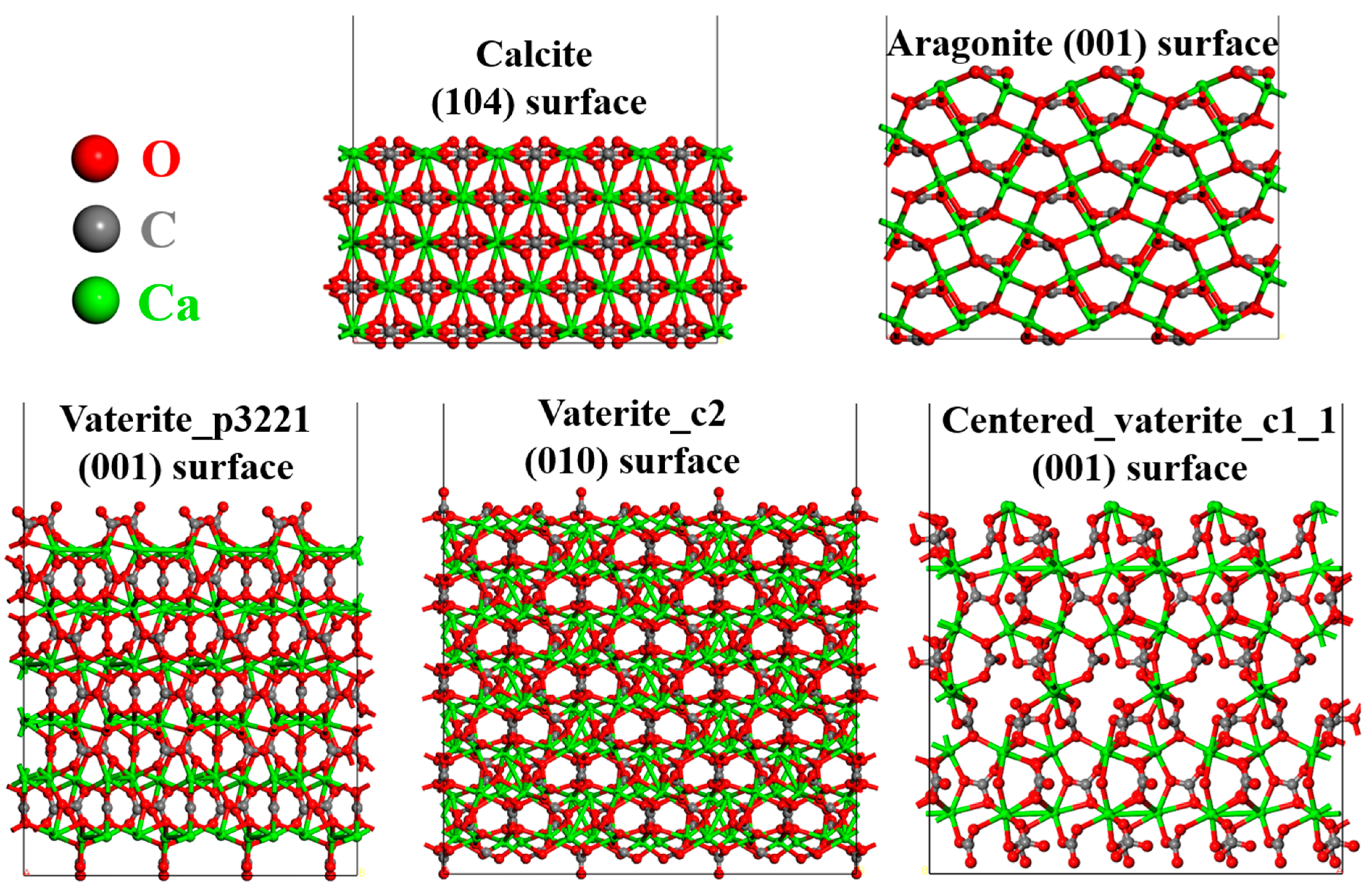
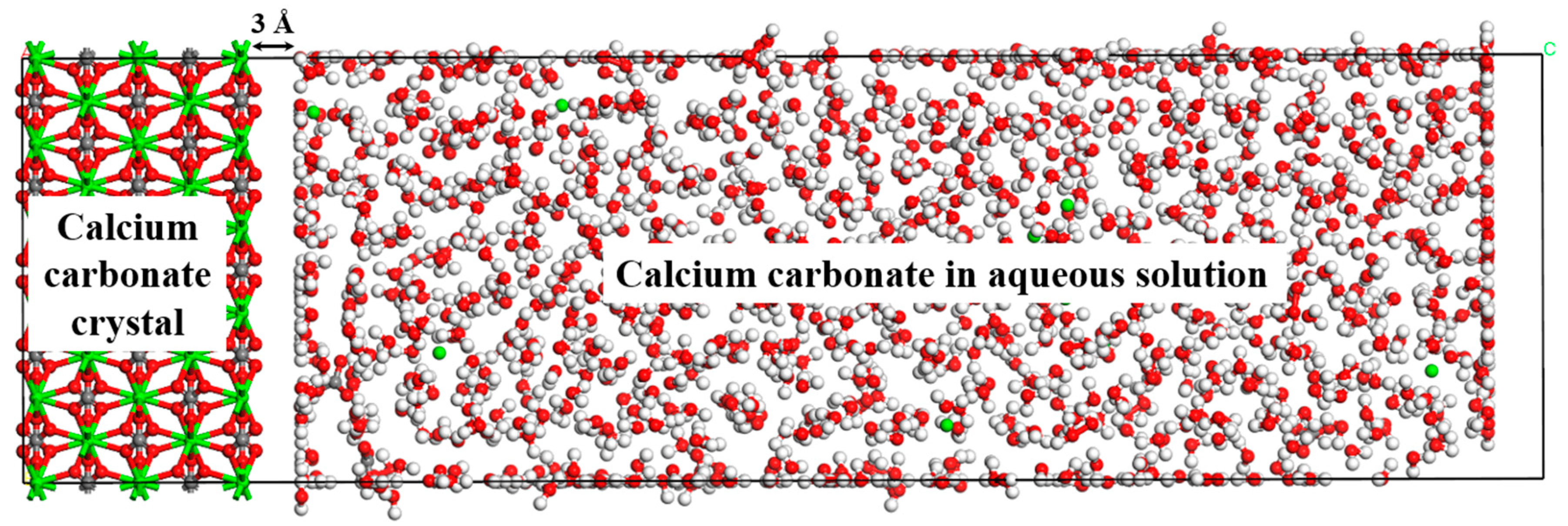
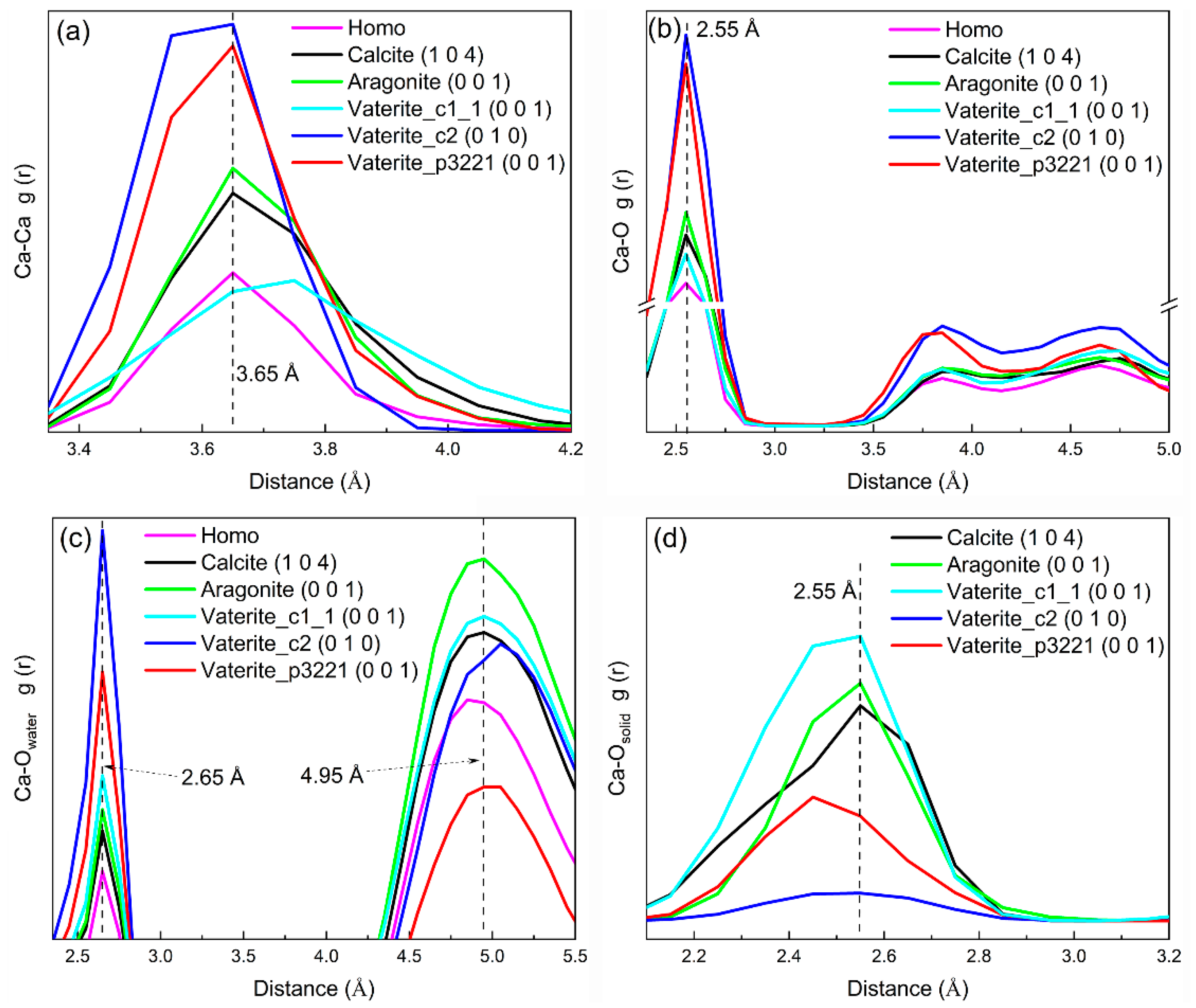
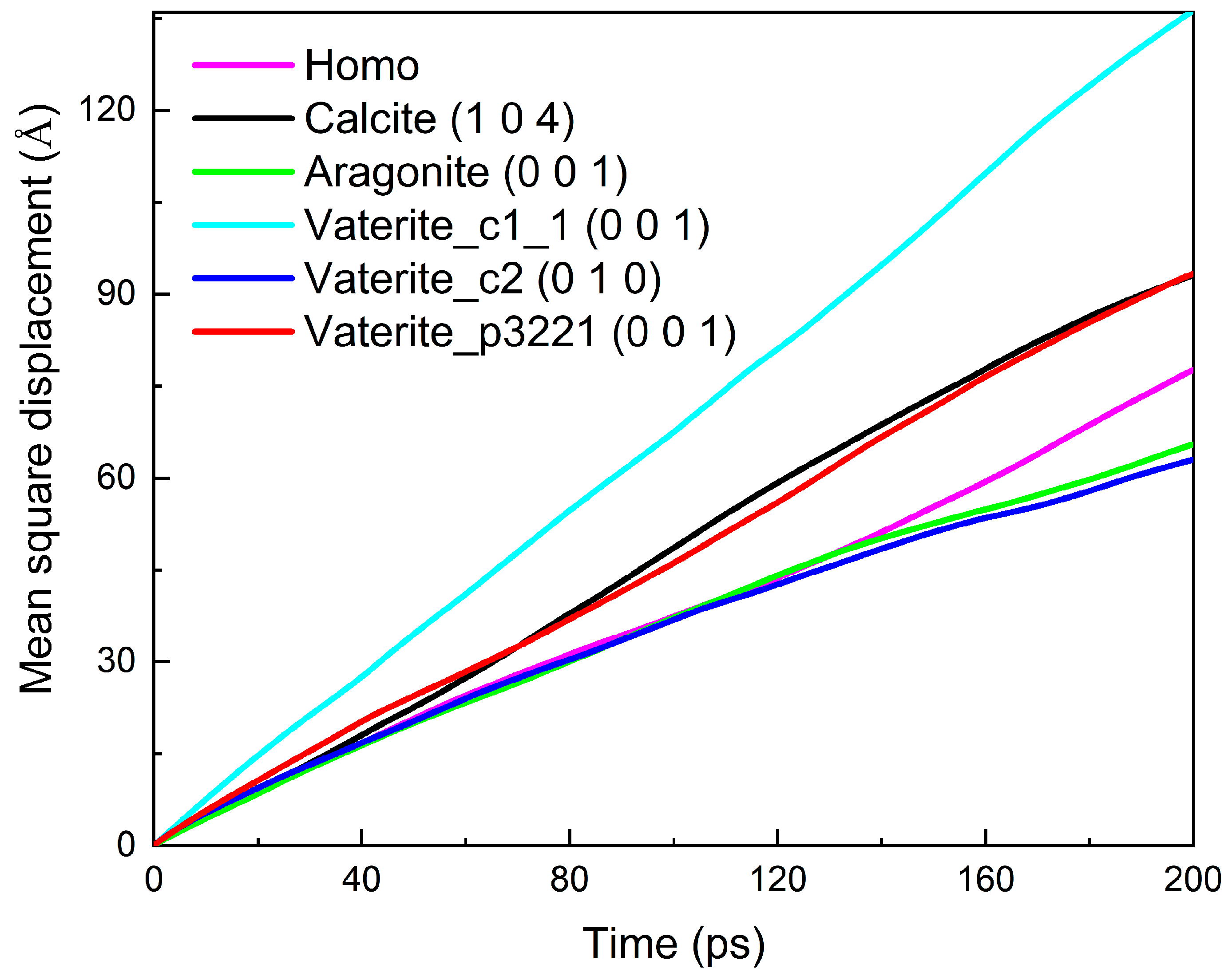
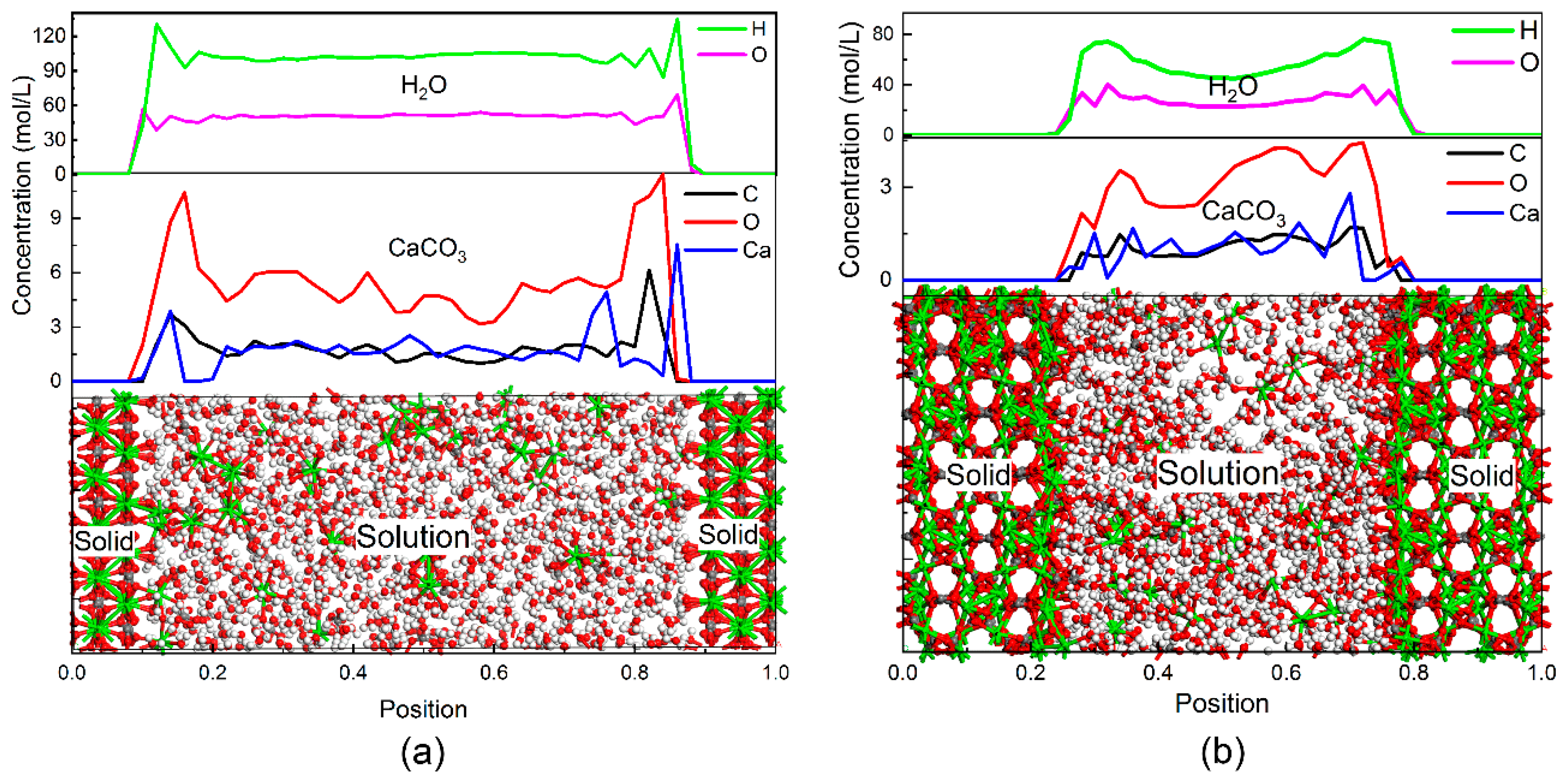

Publisher’s Note: MDPI stays neutral with regard to jurisdictional claims in published maps and institutional affiliations. |
© 2022 by the authors. Licensee MDPI, Basel, Switzerland. This article is an open access article distributed under the terms and conditions of the Creative Commons Attribution (CC BY) license (https://creativecommons.org/licenses/by/4.0/).
Share and Cite
Wang, Z.; Yang, Y.; Jiang, Q.; Hu, D.; Li, J.; Su, Y.; Wang, J.; Li, Y.; Xing, W.; Wang, S.; et al. The Effect of Crystal Seeds on Calcium Carbonate Ion Pair Formation in Aqueous Solution: A ReaxFF Molecular Dynamics Study. Crystals 2022, 12, 1547. https://doi.org/10.3390/cryst12111547
Wang Z, Yang Y, Jiang Q, Hu D, Li J, Su Y, Wang J, Li Y, Xing W, Wang S, et al. The Effect of Crystal Seeds on Calcium Carbonate Ion Pair Formation in Aqueous Solution: A ReaxFF Molecular Dynamics Study. Crystals. 2022; 12(11):1547. https://doi.org/10.3390/cryst12111547
Chicago/Turabian StyleWang, Zhengjiang, Yang Yang, Qi Jiang, Dalong Hu, Jiawei Li, Yan Su, Jing Wang, Yajuan Li, Wenbin Xing, Shoushen Wang, and et al. 2022. "The Effect of Crystal Seeds on Calcium Carbonate Ion Pair Formation in Aqueous Solution: A ReaxFF Molecular Dynamics Study" Crystals 12, no. 11: 1547. https://doi.org/10.3390/cryst12111547




